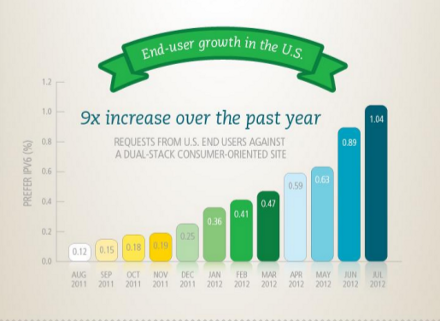IPv6 growth explodes

For years, decades, no one wanted to switch their Internet connection from good old IPv4 to IPv6. Oh, we knew we'd have to move to IPv6 eventually, but we really didn't want to. Now, though, according to Akamai, a Web high-performance company, on the last World IPv6 Day, June 6 2012, IPv6 traffic exploded by 460 times since 2011's World IPv6 Day.
What's more significant though, since every Internet network administrator was tinkering with IPv6 on that day, is that in the year since the 2011 IPv6 Day, Akamai saw a nine-fold increase in IPv6 traffic. And, this growth rate is only increasing. Erik Nygren is Chief Architect at Akamai, wrote, “The IPv6 preference rate for many dual-stacked sites has been steadily rising by a few percent week-over-week since World IPv6 Launch.”

How much is that though in the Internet as a whole? In the U.S. end-user use of IPv6 “has gone from 0.12% a year ago to over 1% today.” That's great.
What's causing this? Nygren thinks there are three IPv6 growth drivers.
"1) Content availability. One major contributor to Akamai's increased IPv6 traffic has come from more of our customers opting in to have their sites, content, and applications permanently available "dual-stacked" (i.e., available over both IPv6 and IPv4) in the months leading up to World IPv6 Launch."
For example, Facebook, Google and Yahoo are all now supporting IPv6 24x7
"2) Availability of IPv6 from access network providers. Over the past year, we've seen some of the largest growth coming from major ISPs within the U.S., as they roll out production IPv6 support to their end-users, including Verizon Wireless, AT&T, and Comcast. This is on top of some ISPs in Europe and Asia that have had IPv6 deployed in production for a few years, as well as a long tail of thousands of network providers, universities, and research labs around the globe. More IPv6 growth will come as these networks extend their IPv6 deployments and as other networks join them."
"3) End-user device support. While most recent desktop and laptop operating systems and client software supports IPv6, many home routers and gateways didn't have support until very recently. Many embedded devices and consumer electronics are also slow to gain IPv6 support, with the notable exception of many 4G LTE smart phones. This has been one of the limiting factors to users whose network providers have rolled out IPv6 capabilities, and as users upgrade devices over the next few years, this should cause a significant increase in IPv6 usage."
Those aren't the only reasons though IPv6 is picking up steam. As Nygren told me several months ago, all public-facing U.S. Federal government sites (PDF link) must be enabled for IPv6 by the end of September 2012." And, of course, there's the simple fact that we really are running out of IPv4 addresses.
Related Stories:
IPv6: When do you really need to switch?
Windows 8 moves to IPv6 Internet
IPv6: It's the end of the Internet as you know it, and I feel fine
First IPv6 Distributed Denial of Service Internet attacks seen
All IPv6 Internet, All the time